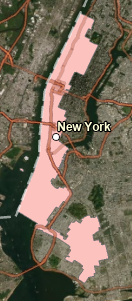Lab 4 [GIS5007]: Data Classification
In this week's lab we examined four different classification methods for displaying data as well as alternative methods for presentation. Four classification methods were studied (Natural Breaks, Equal Interval, Quantile, and Standard Deviation) alongside two presentation styles (percentage of population and population per square mile).
For the map provided above, we can determine from the histogram provided to the right, that this is a skewed, bell-shaped distribution that will make the Standard Deviation and Equal Interval methods poorer candidates for visual contrast, the latter due to the bell-shape, and the former due to the skewness. Alternatively, we can conclude that the Natural Jenks method will likely do a better job compared to the Quantile method because the former method tightens the range for the outliers while also doing a better job differentiating the values above and below the mean.
When deciding which presentation better represents the distribution of seniors in Miami-Dade County, the better choice would be the population count normalized by area. With a senior population, the concentration per square mile within a geographic area is more relevant than the percentage of the population within the same census tracts in terms of planning support services (e.g., health centers, senior centers, and associated transportation networks).
For example, knowing that a large census tract has 50% seniors doesn’t provide enough details to determine if a bus route to a senior center should be planned to this area. If there 10 residents total in this area, a bus route to pick up a maximum of 5 seniors would likely not be a good use of resources. However, knowing the density of seniors per square mile provides more specific information. As another example, if we compare two similarly-sized census tracts, each with 50% seniors, and one has a density of 20 seniors per square mile, while the other has 1000 seniors per square mile, this information can be used to decide which of the tracts is awarded a health center contract, for example, that will likely experience greater utilization of its resources. In this case, it is more likely that the higher number of seniors per square mile would drive higher utilization, and this is the visualization that will best communicate associated planning strategies.





Comments
Post a Comment